Glossary #
- Acceleration Points: consumable points which can be spent to make you master GTS crafting faster. These points are granted to players based on their progress in the legacy system ATS.
- ATS: Ambrosia Tadeskill System, the old crafting system we are migrating from.
- GTS: Goon’s Tradeskill System, our new crafting system.
- Entity: a GTS asset in the game, like a tree you can chop, a plant you can harvest, an animal you can skin, an ore/gem you can mine.
F.A.Q. #
What happened to my old ATS system progress, items, or characters?
- Progress (in the form of ATS points) has been converted at a rate of 5:1 to GTS’s Acceleration points. These points are added up and shared across your entire player account and can be consumed to speed up your progress in the new system. We encourage you to use these to skip parts of GTS that you find boring, or outright too exciting to wait for!
- Items have been automagically converted to the closest GTS counterpart that there is, if such a counterpart exists. If there is no GTS counterpart for a particular item, it will not be replaced and will wait around for a future patch when the ADOH team revamps the item and adds it back into GTS. At that point it will be migrated. There are a few items (such as the tradeskill journal and some recipes) that have little to no value and no equivalent or planned equivalent in GTS. These items have been deleted.
- Characters built around and/or for ATS are not planned to be migrated, or issued free re-rolls. If you wish to adapt your legacy crafters to GTS without rebuilding them anew, we suggest shaving off a few levels and spending some skillpoints on GTS skills.
Where did GTS come from?
Greater trade system (or “Goon’s trade system” to anyone not Goon) was developed here, in-house, by Goon and the rest of the ADOH team. It was primarily a tool-focused project, with more time and effort going into systems and tooling than manual content creation. Besides being a welcome addition to ADOH and a great crafting system, its development included creating a lot of systems that ended up being reusable across the board for other things (see: vault4.0).
Where Where can I find the list of all GTS craftable items?
Here you find a spreadsheet with all possible crafts on GTS!
Known Issues & Non-issues #
- Many of the GTS weapons have appearances that don’t really fit their lore. For example, coldsteel may have the red appearance, or iron that of gold. This is a side-effect of procedurally determining the weapon models, and won’t be looked into until time can be allocated to manually go through and verify each one.
- Some recipe items haven’t been reworked for GTS, yet. This is a work-in-progress and you can always check in on Trello to see what we’re working on!
- Tinkering isn’t ready yet. It will be introduced as a later update to GTS (possibly with a lot of pizazz).
Overview #
Nordock is a land sprawling with danger, enemies, and resources at the very ends of its reaches. As a crafter, you would rather spend your time honing your skills and perfecting your trade, than picking through mountains of brutally murdered goblin remains looking for shiny objects. You’re better than that.
Welcome to the GTS guide. This manual will tell you everything you need to know about ADOH’s intricate crafting system, and how to use it to your advantage.
Resources #
Unless you’re some kind of mega-conjurer (in which case the bank of Benzor would like to have a word with you), you’re going to need resources to craft. These resources are scattered about the lands in a semi-random pattern: some resources prefer certain climates, maps, or biomes and can be found there in greater abundance. If your thick crafter’s skull forgets everything else I just told you, remember this one thing: The location of resources can be determined by examining them in the crafting tree or your inventory. Didn’t get that? Ok, shorter: Examine a resource to see where it spawns. Got it? Good.
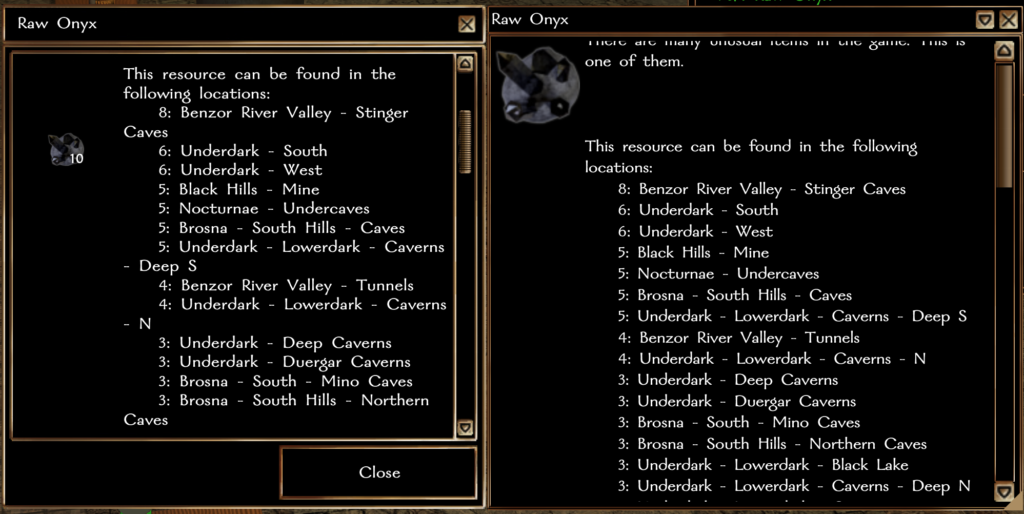
Once you find a resource in the wilds, you’ll need to harvest it with the proper tool. If you use the wrong tool, you’ll only get half! So, if you’re a smart crafter, you’ll carry around a few different tools to make sure you’re always prepared.
The different types of resources are as follows:
Ore Veins #

Ore veins are typically mined with GTS hammers. They are each weak to acid damage (which will dissolve and waste their precious metals) and have differing amounts of hitpoints. Oddly enough, they seem to have some strange affinity with fire damage…
Ore Veins
| Ore | HP | Spawning Conditions |
| Salt | 100 | In underground caves, also in water pools |
| Copper | 100 | In underground caves, CR 0-19 |
| Iron | 150 | In underground caves, CR 0-19 |
| Coldsteel | 200 | In underground caves, CR 0-19 |
| Rubicite | 250 | In underground caves, CR 10-29 |
| Syenite | 300 | In underground caves, CR 10-29 |
| Verdicite | 350 | In underground caves, CR 15-29 |
| Shadow | 400 | In underground caves, CR 20-29 |
| Mithral | 500 | In underground caves, CR 30+ |
Trees #
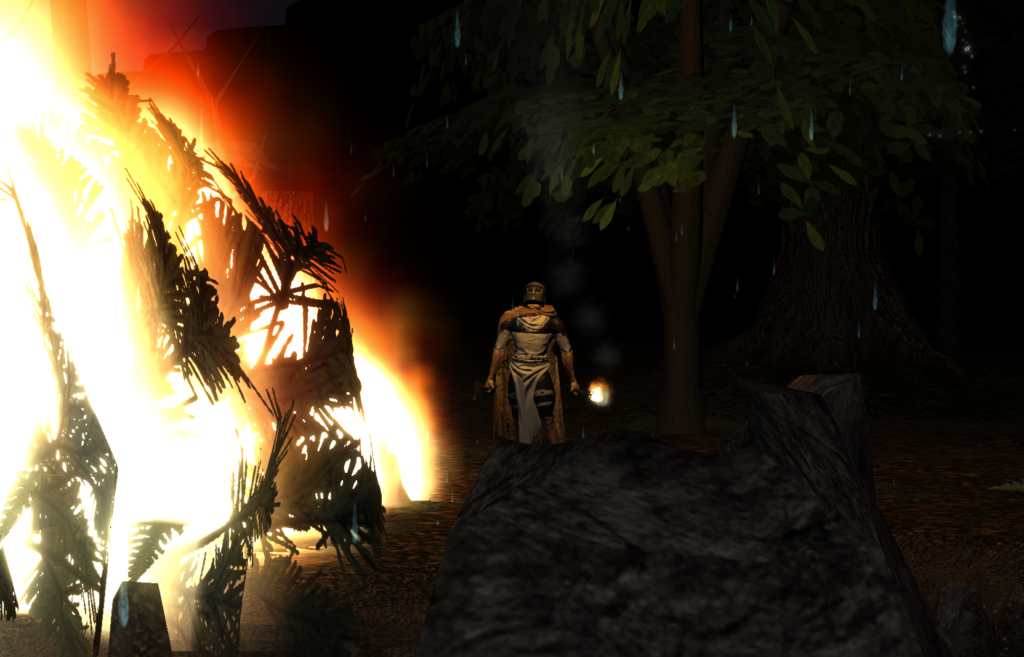
Trees are chopped down with GTS axes (or fists if your name is Steve). Dealing fire damage or interacting with them with a torch will also cause them to catch fire, burning them down and yielding charcoal in the process. Acid works magnificently for decaying these little pests away, and it counts towards the wood yield too!
Trees
| Tree | HP | Spawning Conditions |
| Pine | 100 | In forests, plains, fields, CR 0-19 |
| Cedar | 100 | In forests, plains, fields, CR 0-19 |
| Elm | 150 | In forests, plains, fields, usually in low areas, CR 0-19 |
| Ash | 200 | In forests, plains, fields, CR 10-29 |
| Red Palm | 200 | On beaches, in desert oasis, CR 10-29 |
| Oak | 300 | In forests, plains, fields, CR 15-29 |
| Snakewood | 300 | In water, CR 15-29 |
| Desert Ironwood | 600 | In deserts, CR 30+ |
Animals #
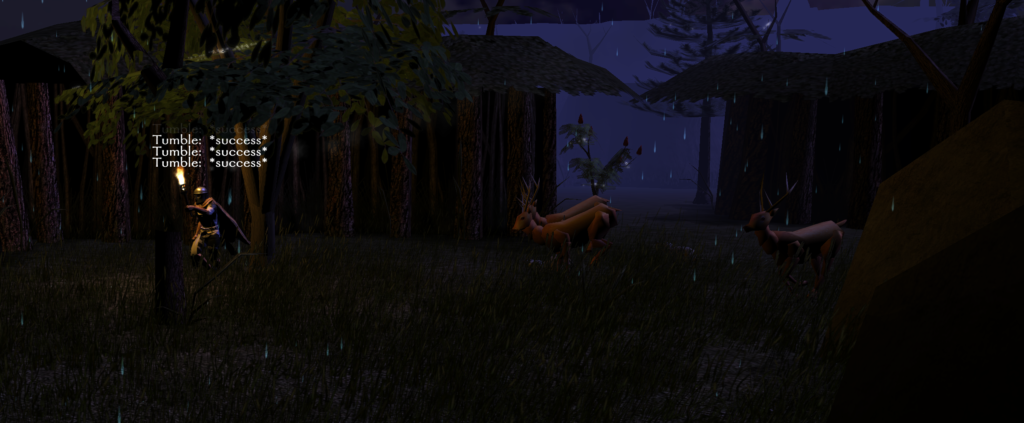
Animals are killed via any means possible. Just make sure to bring a shortsword or a knife to skin them with when you’ve done the job.
Animals
| Animal | Spawning Conditions |
| Badger | In plains, forests |
| Deer | In plains, forests |
| Bear | In In plains, forests, caves |
Herbs #
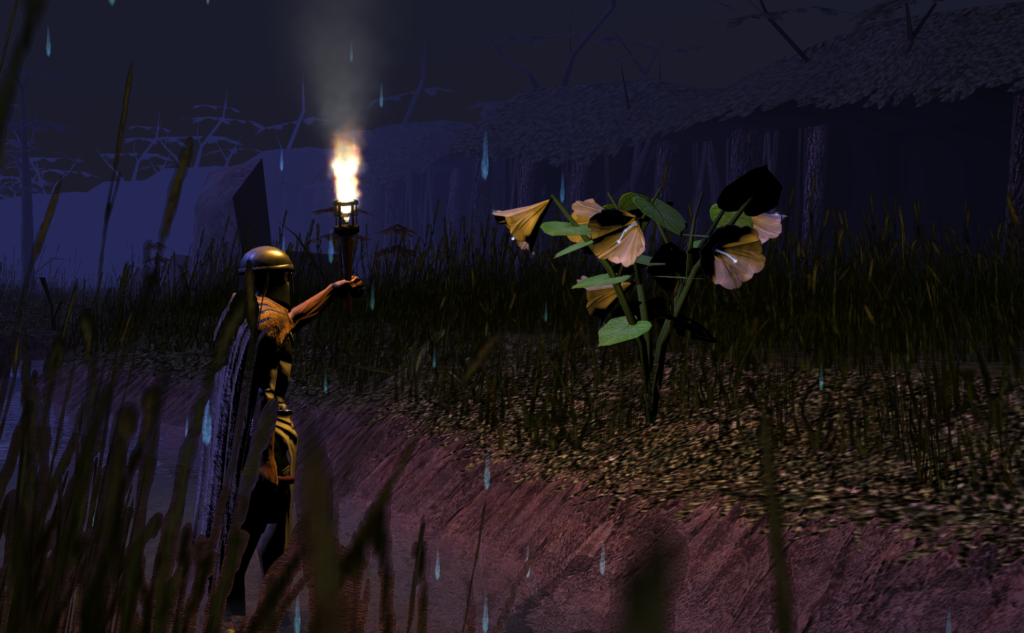
Herbs are harvested with anything and everything. You just walk up to one and pluck it out of the ground. They’re not very tough, you see.
Herbs
| Herb | Spawning Conditions |
| Moonflower | In plains, near water |
| Turmeric | On sand |
| Red Sumac | Near trees, buildings, or cliffs. In plains, forests, and mountains |
| Indigo | On grass |
| Niphredil | In cold areas, on snow |
| Elanor | Underground, on stone, near water |
Gems #
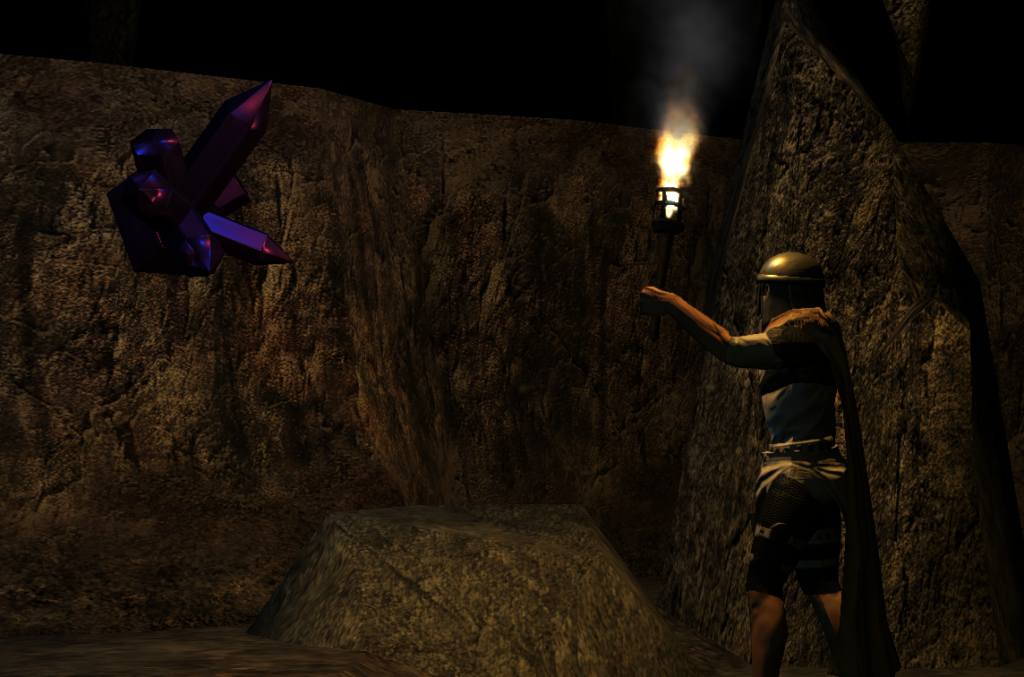
Gems are mined with GTS hammers. They differ from ores in that they don’t show any particular weaknesses to any damage type, and they tend to form on walls and in clusters.
Gems
| Gem | HP | Spawning Conditions |
| Citrine | 350 | In underground caves, CR 0-19 |
| Jade | 350 | In underground caves, CR 0-19 |
| Onyx | 350 | In underground caves, CR 0-19 |
| Opal | 350 | In underground caves, CR 0-19 |
| Lapis Lazuli | 350 | In underground caves, CR 0-19 |
| Amethyst | 350 | In underground caves, CR 0-19 |
| Topaz | 600 | In underground caves, CR 15-29 |
| Emerald | 600 | In underground caves, CR 15-29 |
| Black Sapphire | 600 | In underground caves, CR 15-29 |
| Diamond | 600 | In underground caves, CR 15-29 |
| Sapphire | 600 | In underground caves, CR 15-29 |
| Ruby | 600 | In underground caves, CR 15-29 |
Crafting #
Crafting is done at a crafting station. There are many crafting stations for many different trades, and you are encouraged to browse about and experiment with them all. Crafting stations can generally be found at your local workshop in your home city.
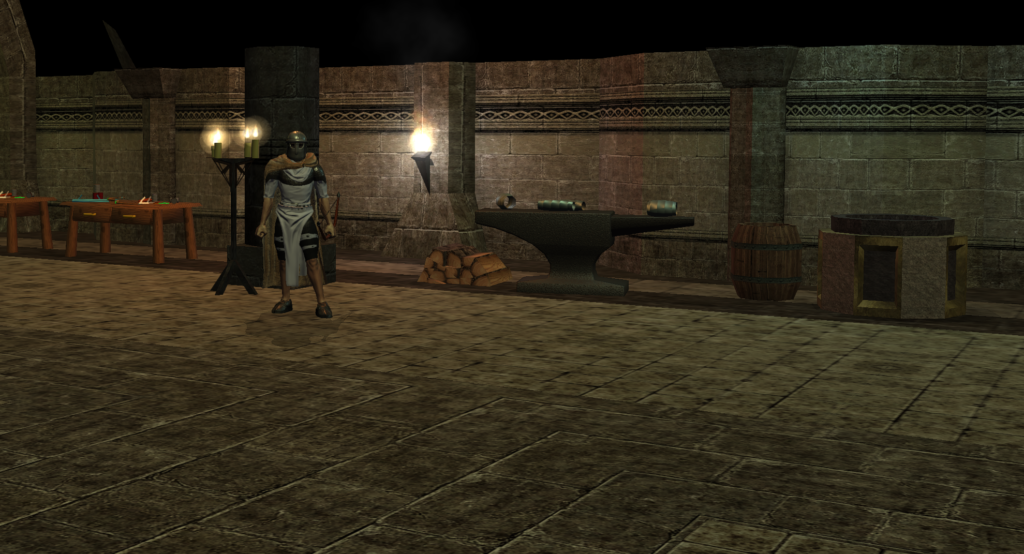
The first thing you are going to want to craft, at the weaponsmithing station, is an axe and a hammer. You can use these immediately and begin to gather all of your resources when mining and chopping, instead of half.
The Tree #
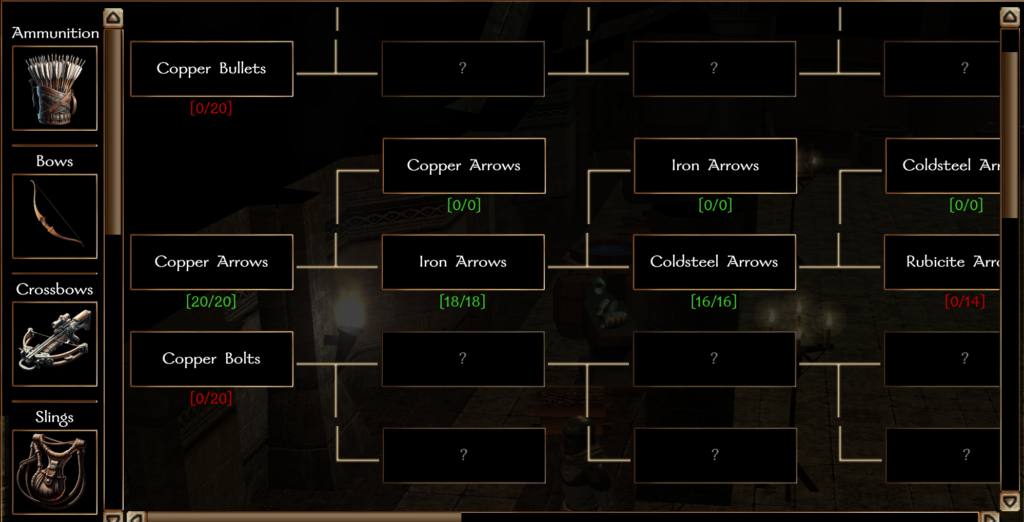
The crafting tree is a visual representation of the crafting system. It is a branching tree of recipes, with each recipe leading to more recipes. Shown on each node (representation of a recipe) is the _skill_. Each time you attempt to craft that recipe, the skill will go up until it hits the maximum value. Once it does hit the maximum value, the chance of succeeding at the craft will be 100% and you will unlock the next recipes in the tree.
The Recipe #
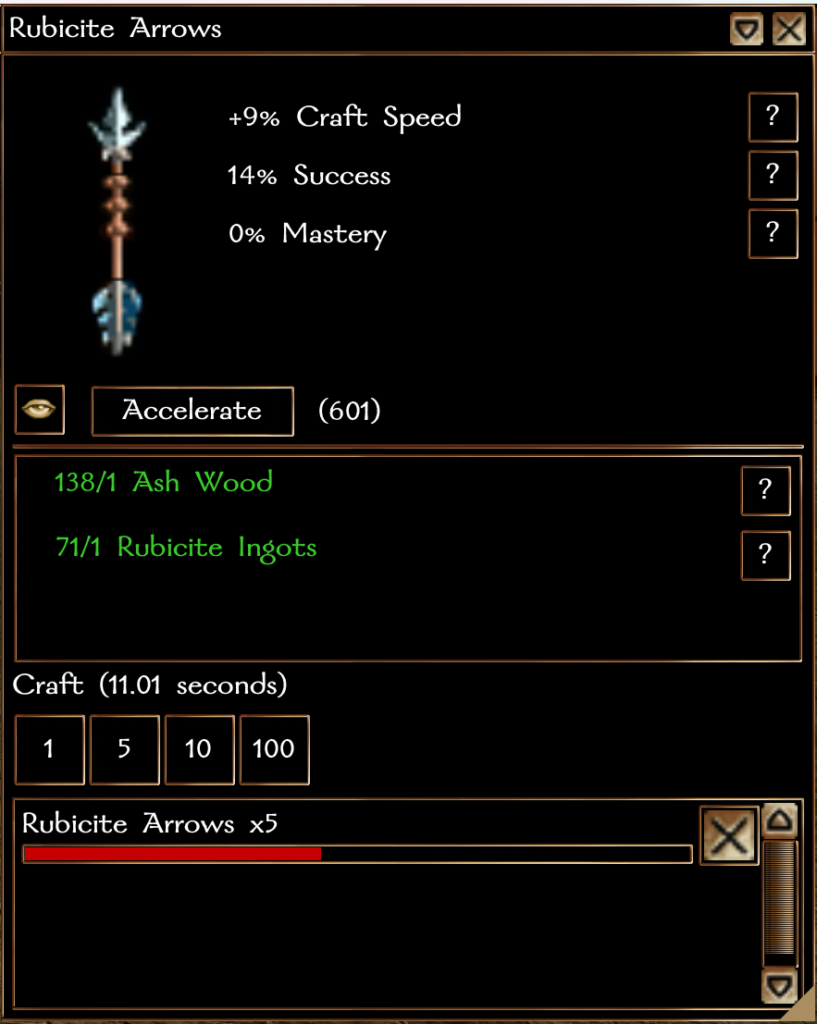
When you select a recipe, you will be presented with a little window with a ton of useful options. Listed right by the icon are the speed, skill, mastery (these are explained in the Mechanics section below), and just below that are the ingredients. The ingredients will be colored green if you have enough, or red if you lack the resources to craft the item. If you have enough resources, you can click the [1], [5], [10], or [100] buttons to queue up that many crafts.
The Queue #

When you queue up a craft, it will be added to the queue. When there are items in the queue your character will begin crafting it if they are near an unoccupied crafting station. You can cancel individual queue entries one at a time by left clicking on the ‘X’ icon, or right-click to remove the entire entry.
If you walk away from your crafting station, the queue will be paused until you return. If you log out, the queue will be cleared.
Mechanics #

The above covers everything you need to know to get started, and to start producing crafted items. However, if you wish to take crafting to the next level and really optimize your output, you’ll need to know the mechanics.
Harvesting #
When you harvest resources, such as pelts or wood, it’s all modified by your harvesting modifier. Generally, you can see a breakdown of the harvesting modifier by examining the item to be harvested. The harvesting modifier is a combination of your character’s Craft: Harvesting skill and the relevant ability score for that resource. Different resource types use different ability scores:
| Resource | Ability Score |
| Mining | Strength |
| Chopping | Constitution |
| Skinning | Wisdom |
| Gathering (Herbs) | Dexterity |
By raising the combination of your harvesting skill and the relevant ability score, you can increase the amount of resources you gather dramatically.
Speed & Synergy #
Speed is a measure of how quickly you can craft an item. It is modified by your character’s Craft: Speed skill combined with recipe synergy bonuses. A synergy bonus is a speed boost you can obtain by mastering a similar recipe. In most cases these recipes will be in the same column of the crafting tree, but not always. For example, mastering the recipe for a copper longsword will give you a synergy bonus, and therefore a slight speed boost, when crafting a copper shortsword.
Mastery #
Mastery is a measure of how well you can craft an item. It is a cumulation of your character’s Craft: Mastery skill, the trade’s relevant ability score, and the percentage that you have mastered the recipe. Each recipe has a number of skill points associated with it, and each time you attempt to craft that recipe, the skill will go up until it hits the maximum value. On the way up, you receive a success chance (mastery) equal to the percentage of the recipe you have mastered. Once you have mastered the recipe, the chance of succeeding at the craft will be 100%.

After adding the recipe’s base mastery %, the Craft: Mastery skill will be added, and finally there will be a bonus based on your ability score which depends on the trade:
| Trade | Ability Score |
| Archercrafting | Dexterity |
| Armorsmithing | Constitution |
| Jewelcrafting | Charisma |
| Leatherworking | Wisdom |
| Tailoring | Wisdom |
| Weaponsmithing | Strength |
With all of these values added together, it is possible to reach numbers higher than 100% mastery. When your skill is over 100%, the overflow becomes your chance to craft [Masterful] items instead of normal ones. [Masterful] items have identical stats to normal ones, but they count towards the [Vengeful] set bonus allowing you to receive an improved bonus and combine it with other [Vengeful] items.